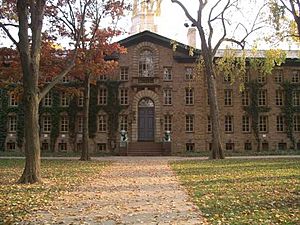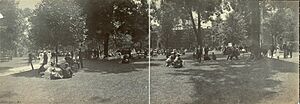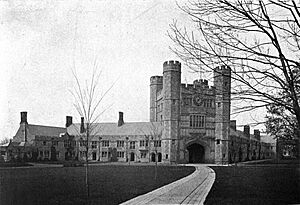History of Princeton University facts for kids
Princeton University is a famous school that started in 1746 in Elizabeth, New Jersey. It was first called the College of New Jersey. Soon after, it moved to a new building called Nassau Hall in Princeton. In 1783, for about four months, Nassau Hall was even the home of the United States Congress! Many students from Princeton later became important leaders in the early days of the United States.
The school officially became Princeton University in 1896. It grew a lot when Woodrow Wilson, who later became a U.S. president, was in charge. Later, in 1969, Princeton started accepting both male and female students.
Contents
Founding the College of New Jersey
Princeton University began in 1746 as the College of New Jersey. It was founded in Elizabeth, New Jersey.
New Light Presbyterians started the college to train ministers. The school was very important for education and religion for Scottish-Irish Americans. In 1746, New Jersey gave the college a special paper called a charter. This charter said that "any Person of any religious Denomination whatsoever" could attend. This was very unusual for the time.
The first classes had only 10 young men. They met in the home of Reverend Jonathan Dickinson. After he passed away, Aaron Burr Sr. took over. The college then moved to Newark, New Jersey in 1747. In 1748, the first six students graduated there.
Moving to Princeton
In 1756, the College of New Jersey moved to its new home in Nassau Hall. This building is in Princeton, New Jersey. Nassau Hall was named to honor King William III. He was the Prince of Orange from the House of Nassau.
Nassau Hall was one of the biggest buildings in the American colonies. For almost 50 years, it held everything for the college. This included classrooms, dorms, the library, and dining areas. During the American Revolution, soldiers from both sides used the building. Today, you can still see a cannonball mark from the Battle of Princeton in 1777. The U.S. government made "Old Nassau" a national landmark because it is so important.
After the first five presidents died young, the college had a stable time from 1768 to 1794. This was under Reverend John Witherspoon. The war badly damaged the college. In 1802, a fire destroyed Nassau Hall. Later, in 1814, students caused some trouble, including an explosion at the front door.
Witherspoon was a key leader in both religion and politics. He was one of the people who signed the Declaration of independence. He also signed the Articles of Confederation.
When John Witherspoon became Princeton's president in 1768, he changed the school. It had mostly trained ministers before. He made it a place to train leaders for the new nation. Witherspoon changed what students learned about morals and science. He wanted students to think for themselves. He believed that everyone could learn to be good, whether they were religious or not.
Many of his students became important figures in the new United States. These included James Madison and Aaron Burr. Witherspoon also helped lead New Jersey towards the American Revolution. In 1783, the Continental Congress met in Nassau Hall. This made Princeton the temporary capital of the United States. Nine Princeton graduates attended the meeting to create the U.S. Constitution in 1787. This was more than from any other school.
The 1800s
In the early 1800s, there were some problems between students and teachers. The school had strict rules and crowded dorms. This led to a student riot in 1807.
In 1812, the Princeton Theological Seminary was started as a separate school. It focused only on training people for religious work. The college agreed because it needed more specialized training than the college could offer. The two schools have always had a close connection.
Before the Civil War, Princeton University was careful about slavery. It did not strongly support slavery, but it also did not support radical anti-slavery ideas. This was because the college followed a conservative religious view. However, the town of Princeton had a lively community of free Black people. They even had their own churches. By the late 1850s, the college started to support Abraham Lincoln and his views on slavery.
In the late 1800s, there was a debate at Princeton about science and religion. This was about Charles Darwin's theory of evolution. James McCosh, who was president from 1868 to 1888, was the first American religious leader to publicly support evolution. Both McCosh and a professor named Charles Hodge believed in scientific study. This debate helped the college become known for excellent scholarship.
Francis Landey Patton was president from 1888 to 1902. Many people felt he was holding Princeton back. He wanted a more traditional Christian education. This limited academic freedom and made it hard for Princeton to become a major American university. He was removed from his position in 1902.
Becoming Princeton University
In 1896, the College of New Jersey changed its name to Princeton University. This happened during its 150th anniversary celebration. Princeton also adopted a motto: "Princeton in the nation’s service." This was the title of a speech by professor Woodrow Wilson.
Woodrow Wilson's Leadership
In 1902, Woodrow Wilson became Princeton's 13th president. During his time as president (1902–1910), plans for a graduate school were completed. The College of New Jersey began to grow into a full university.
Wilson wanted to improve how students learned and were taught. He started small discussion classes called "preceptorials." These are still used today in many subjects. He also doubled the number of teachers. He created a new way to organize the school. He changed the courses so that freshmen and sophomores studied general topics. Juniors and seniors focused on one main subject.
Wilson also suggested that student dorms be divided into smaller "colleges." Students would live with teachers and have their own recreation areas. A version of this idea came true in 1982. Five residential colleges were created for freshmen and sophomores.
Wilson did not allow Black students at Princeton during his time. Other Ivy League schools were starting to accept a few Black students. Princeton did not have its first Black graduate until 1948.
Wilson wanted students and teachers to eat and talk together. He tried to change the "eating clubs" where students mostly ate with each other. But he was not successful, and the eating clubs are still there today.
Wilson believed the college should train a small group of students to be national leaders. He called them "the minority who plan, who conceive, who superintend." He said the college was still democratic even if it focused on these special students.
Student Life and Changes
Princeton University was often featured in books about student life. These books showed what campus life was like in different decades.
In the early 1900s, Princeton was a trendsetter in men's fashion. The students' casual style influenced clothing across the country for many years.
Football faced problems in the early 1900s because of serious injuries. The presidents of Harvard, Yale, and Princeton worked together to make changes to the sport. They wanted to reduce injuries. In 1939, the "Big Three" schools (Harvard, Yale, Princeton) expanded and became the Ivy League.
During World War II, many Princeton students joined the military. The university became very involved in training soldiers and sailors. These wartime changes helped Princeton connect more with the rest of American society.
Before World War II, many top universities, including Princeton, limited who could attend. They often did not admit Jewish people, Black people, or other minorities. After the war, this changed. Colleges started to accept more diverse students. Many veterans also came to college using the GI Bill. By the 1950s and 1960s, Princeton and other major schools began to admit more minorities.
Religion and Mathematics
In the early 1900s, most Princeton students were from high-status Protestant families. Over time, more liberal Christian ideas became popular among students. By the 1920s, Princeton stopped being mainly a Presbyterian school. A large interdenominational chapel was built, showing this change.
In the 1920s, Princeton's math department became a major center for math research. A leading mathematician named Oswald Veblen helped secure funding for the department. This made Princeton a very important place for studying mathematics.
The 1960s and 1970s
The Vietnam War also affected Princeton. Students protested against the war. Some students were suspended for demanding that a government official talk about the war.
In 1971, the Third World Center was founded. It is now called the Carl A. Fields Center. This center was created to support minority students and give them a place for academic, political, and social activities.
The 1980s to Today
In 1982, the residential college system was officially started. This system provides smaller communities for students on campus. During President William G. Bowen's time (1982-1988), Princeton's money grew a lot. He also led a big fundraising effort.
President Harold T. Shapiro followed Bowen and was president until 2001. He continued to increase the university's funds and expand its academic programs. He also helped make the student body more diverse. Many buildings were renovated during his time.
In 2001, Princeton chose its first female president, Shirley M. Tilghman. Before she retired in 2012, she expanded financial aid for students. She also oversaw several large construction projects on campus.
Princeton's current president, Christopher Eisgruber, was elected in 2013. In 2017, Princeton started a big project to study its historical connections to slavery. This project, called the Princeton & Slavery Project, shared many historical documents and essays. In 2018, the university decided to name two public spaces after James Collins Johnson and Betsey Stockton. They were enslaved people who lived and worked on Princeton's campus. Their stories were shared through this project.
Princeton's Impact on the Nation
Three future U.S. presidents studied at Princeton. Two of them graduated from the university. James Madison, the fourth president, graduated in 1771. He was an important founding father. Woodrow Wilson, the 28th president, graduated in 1879. Wilson also served as Princeton's president from 1902 to 1910. Future President John F. Kennedy started his studies at Princeton in 1935. However, he left due to illness and later transferred to Harvard University.
Princeton University has produced 29 Nobel laureates. These are people who have won the Nobel Prize for their amazing achievements. Many great thinkers of the 20th century were connected to Princeton. The university has also produced several Fields Medallists, who are top mathematicians.
Princeton's students and teachers continue a tradition of excellent education that started over 250 years ago. The few books in the first classroom have grown into a huge library. Firestone Library now has over five million books. The original campus has grown to about 600 acres with more than 160 buildings.
Today, over 1,200 full and part-time teachers work at Princeton. They publish more than 2,000 scholarly papers each year. Princeton's teachers work with both undergraduate and graduate students.
Princeton used to be only for young men. But in 1969, it became a school for both men and women. Today, about 5,000 undergraduate students and 2,500 graduate students attend Princeton. Most of them live on campus.
Princeton is one of the smaller top research universities in the country. Its size allows students and teachers to work closely together. This happens in all kinds of classes, from introductory courses to senior projects.
See also
- Princeton University
- President of Princeton University





